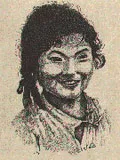Newar - The Newah People
 It is not surprising that the Newar people were influenced by Tibet and India. What is surprising is their creativity response to this stimulus, which actually led to a genuine exchange with their giant neighbors. Mediaeval Near society has left a religious architectural and artistic legacy that is unique, and spectacular by any standard.
It is not surprising that the Newar people were influenced by Tibet and India. What is surprising is their creativity response to this stimulus, which actually led to a genuine exchange with their giant neighbors. Mediaeval Near society has left a religious architectural and artistic legacy that is unique, and spectacular by any standard.
Although most Newars have Mongoloid physical characteristics, some don't, so their origins are shrouded in mystery. It is now generally accepted that they are a mixture of many different peoples who were attracted to the valley, possibly origination with the Kiratis, or an even earlier group, Perhaps the Newars' most striking characteristic is their love of communal life. Newar houses were invariably clustered together, usually around sites of religious significance. Although their economy was centered around agriculture and trade, they created sophisticated urban communities which catered to a breadth of human needs in an integrated way that has rarely been matched.
Today there are around 600,000 Newars largely centered in the Kathmandu Valley. Always traders and merchants, the Newars continue to fill this role throughout the kingdom. Their proximity to the center of power has also led to them having a disproportionate influence in the bureaucracies of Kathmandu. many now live in heartbreakingly ugly bungalows on the outskirts of the city proper, and many of their traditions are on the wane.